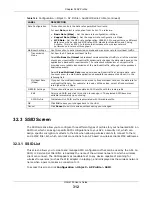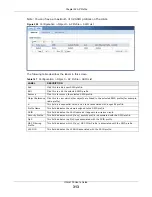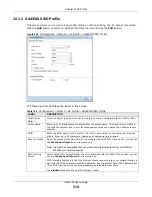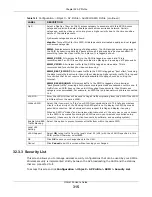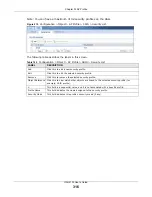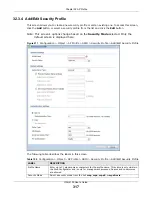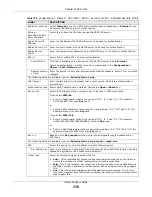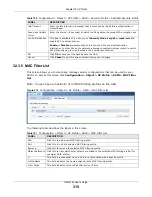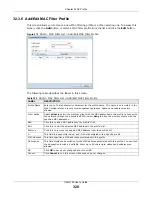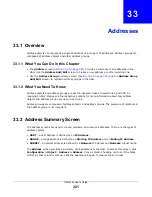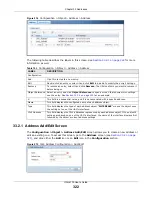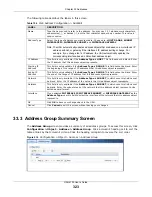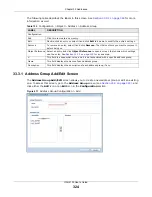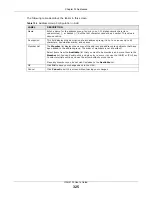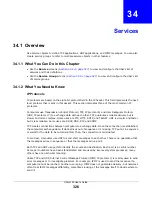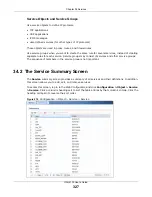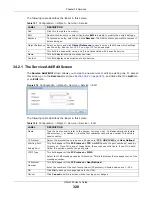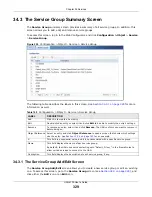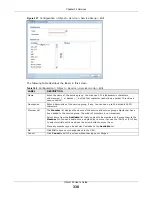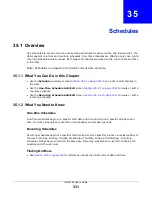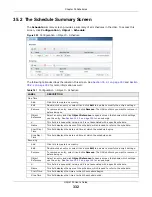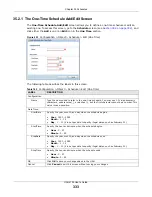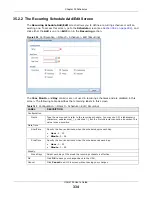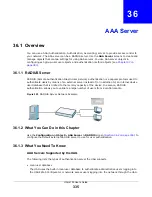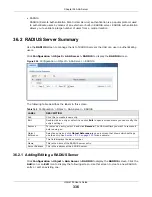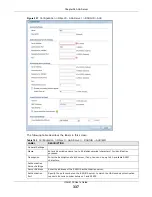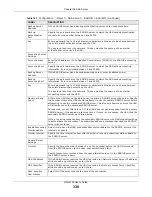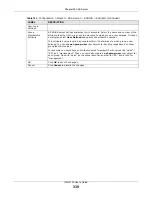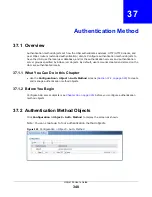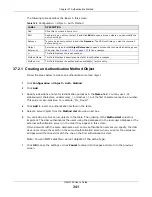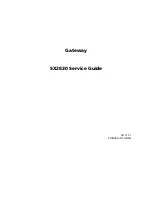
UAG4100 User’s Guide
326
C
H A P T E R
3 4
Services
34.1 Overview
Use service objects to define TCP applications, UDP applications, and ICMP messages. You can also
create service groups to refer to multiple service objects in other features.
34.1.1 What You Can Do in this Chapter
• Use the
Service
) to view and configure the UAG’s list of
services and their definitions.
• Use the
Service Group
screens (
) to view and configure the UAG’s list
of service groups.
34.1.2 What You Need to Know
IP Protocols
IP protocols are based on the eight-bit protocol field in the IP header. This field represents the next-
level protocol that is sent in this packet. This section discusses three of the most common IP
protocols.
Computers use Transmission Control Protocol (TCP, IP protocol 6) and User Datagram Protocol
(UDP, IP protocol 17) to exchange data with each other. TCP guarantees reliable delivery but is
slower and more complex. Some uses are FTP, HTTP, SMTP, and TELNET. UDP is simpler and faster
but is less reliable. Some uses are DHCP, DNS, RIP, and SNMP.
TCP creates connections between computers to exchange data. Once the connection is established,
the computers exchange data. If data arrives out of sequence or is missing, TCP puts it in sequence
or waits for the data to be re-transmitted. Then, the connection is terminated.
In contrast, computers use UDP to send short messages to each other. There is no guarantee that
the messages arrive in sequence or that the messages arrive at all.
Both TCP and UDP use ports to identify the source and destination. Each port is a 16-bit number.
Some port numbers have been standardized and are used by low-level system processes; many
others have no particular meaning.
Unlike TCP and UDP, Internet Control Message Protocol (ICMP, IP protocol 1) is mainly used to send
error messages or to investigate problems. For example, ICMP is used to send the response if a
computer cannot be reached. Another use is ping. ICMP does not guarantee delivery, but networks
often treat ICMP messages differently, sometimes looking at the message itself to decide where to
send it.
Содержание UAG4100
Страница 43: ...Chapter 3 Printer Deployment UAG4100 User s Guide 43 ...
Страница 118: ...Chapter 10 Interfaces UAG4100 User s Guide 118 Figure 76 Configuration Network Interface Ethernet Edit External Type ...
Страница 119: ...Chapter 10 Interfaces UAG4100 User s Guide 119 Figure 77 Configuration Network Interface Ethernet Edit Internal Type ...
Страница 129: ...Chapter 10 Interfaces UAG4100 User s Guide 129 Figure 82 Configuration Network Interface PPP Add ...
Страница 207: ...Chapter 20 UPnP UAG4100 User s Guide 207 Figure 133 Network Connections My Network Places Properties Example ...
Страница 221: ...Chapter 24 Web Authentication UAG4100 User s Guide 221 Figure 146 Configuration Web Authentication Web Portal ...
Страница 222: ...Chapter 24 Web Authentication UAG4100 User s Guide 222 Figure 147 Configuration Web Authentication User Agreement ...
Страница 267: ...Chapter 26 Billing UAG4100 User s Guide 267 Figure 184 Configuration Billing Payment Service Custom Service ...
Страница 355: ...Chapter 38 Certificates UAG4100 User s Guide 355 Figure 237 Configuration Object Certificate Trusted Certificates Edit ...
Страница 404: ...Chapter 41 Log and Report UAG4100 User s Guide 404 Figure 283 Configuration Log Report Email Daily Report ...
Страница 408: ...Chapter 41 Log and Report UAG4100 User s Guide 408 Figure 285 Configuration Log Report Log Settings Edit System Log ...
Страница 413: ...Chapter 41 Log and Report UAG4100 User s Guide 413 Figure 287 Configuration Log Report Log Settings Edit Remote Server ...
Страница 466: ...Appendix B Legal Information UAG4100 User s Guide 466 Environmental Product Declaration ...

